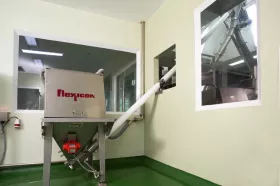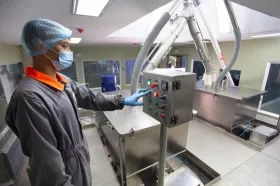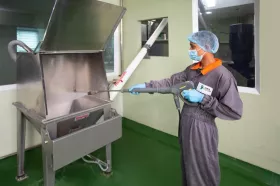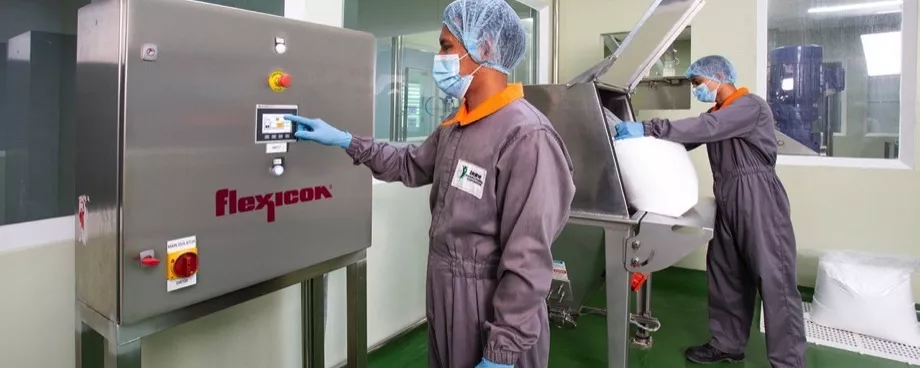
Meeting increased demand for Blaine's popular premixes and marinades required the plant to add a new process comprised of a flexible screw conveying system that feeds powdered ingredients to dual 1000 kg (1.1 U.S. ton) capacity ribbon blenders.
With a production target of 8000 - 10,000 kg (8.8 - 11 U.S. tons) per day, the company acquired a semi-automated, closed system to maintain a clean plant environment and reduce the physical burden on the operators who were manually loading 25 kg (55 lb) bags of ingredients into the blenders. One of Blaine’s technical consultants suggested the Flexicon system.
Moving Ingredients from Bags to Blenders

The semi-automated system consists of a 316 stainless steel floor hopper with an integrated flexible screw conveyor discharging through a wye diverter that feeds either ribbon blender selectively. The floor hopper and control panel are housed in a separate room from the blending operation, with the flexible screw conveyor passing through an opening in the adjoining wall. The IP65 variable speed control panel has a human-machine-interface (HMI) for operation of the conveyor and actuation of the diverter valve.
Ingredients arrive at the plant in 25 kg (55 lb) bags on pallets staged by the floor hopper. For each batch, operators empty the required number of bags into the 140 L (5 cu ft) hopper equipped with a grate to catch any oversize objects. A fold-down bag support tray helps operators to stage, open and dump bags.
The 6 m (20 ft) long flexible screw conveyor inclined at 40° discharges through a pneumatically-actuated 150 mm (6 in.) round wye diverter valve feeding the ribbon blenders. The stainless steel spiral, enclosed in food grade polymer outer tubing, is the only moving part that contacts the material. It is driven by an electric motor positioned beyond the discharge point, preventing material contact with bearings or seals. The operation of the conveyor and wye diverter are managed at the control panel to determine the material destination and feed rate.
Improving Ergonomics and Plant Hygiene

Previously, ingredients were manually dumped directly into the original 500 kg (1102 lb) capacity ribbon blender. With the addition of two larger blenders, the automated conveying system allows ingredients to be loaded into the floor hopper at an ergonomic height and conveyed to the ribbon blenders, reducing the physical burden on operators and minimizing dusting by being enclosed.
Loading and blending takes about 45 minutes, after which the batch is discharged into a dispensing tank with a screw feeder that moves the material to a load-cell-equipped filler for PE-lined kraft bags. Once filled, the bags are heat sealed, sewn, and sent down through a roller conveyor.
The flexible screw is removed daily through a quick-release clean-out cap, and wiped down, while the conveyor tube and hopper are cleaned in place.
New Handling System for an established Product

Process validation of three batches of powder marinade premix was conducted to establish the most efficient procedure using the flexible screw conveying system. The company noted that the material handling, work safety/convenience and hygiene markedly improved.
In addition to marinades, seasonings and premixes will be validated and run through the flexible screw conveyor system, going forward.
Since the company also offers tolling services to multinational clients, the new conveying system will be an advantage, serving as a showcase for the food manufacturing plant.
■
















